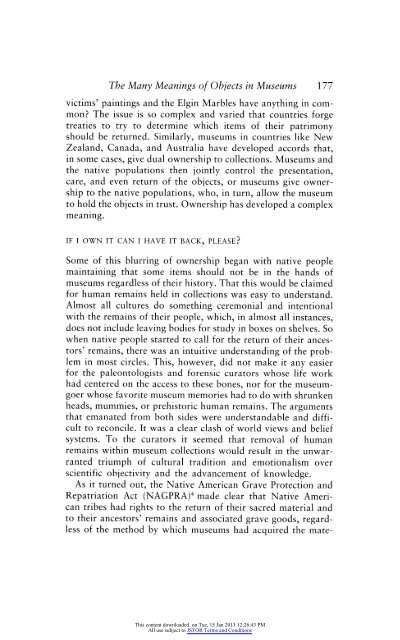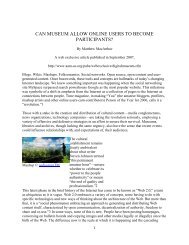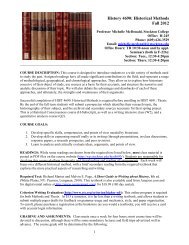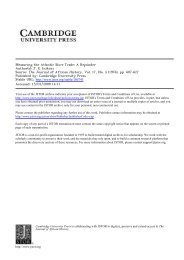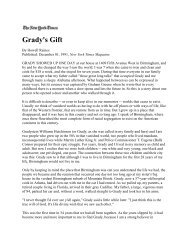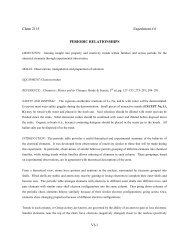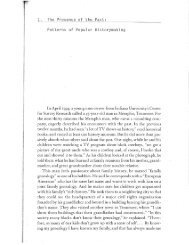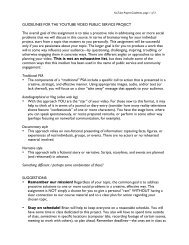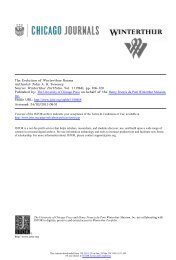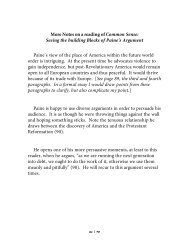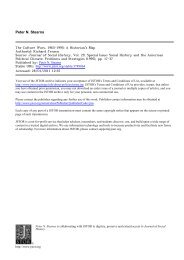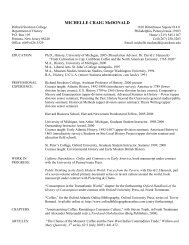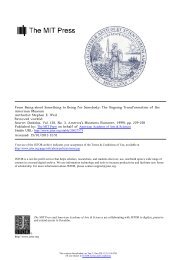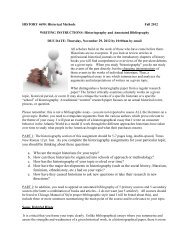What Is the Object of This Exercise? A Meandering Exploration of ...
What Is the Object of This Exercise? A Meandering Exploration of ...
What Is the Object of This Exercise? A Meandering Exploration of ...
You also want an ePaper? Increase the reach of your titles
YUMPU automatically turns print PDFs into web optimized ePapers that Google loves.
The Many Meanings <strong>of</strong> <strong>Object</strong>s in Museums 177<br />
victims'<br />
paintings and <strong>the</strong> Elgin Marbles have anything in com<br />
mon? The issue is so<br />
complex and varied that countries forge<br />
treaties to try to determine which items <strong>of</strong> <strong>the</strong>ir patrimony<br />
should be returned. Similarly,<br />
museums in countries like New<br />
Zealand, Canada, and Australia have developed accords that,<br />
in some cases, give dual ownership<br />
to collections. Museums and<br />
<strong>the</strong> native populations <strong>the</strong>n jointly control <strong>the</strong> presentation,<br />
care, and even return <strong>of</strong> <strong>the</strong> objects,<br />
or museums<br />
give<br />
owner<br />
ship<br />
to <strong>the</strong> native<br />
populations, who, in turn, allow <strong>the</strong> museum<br />
to hold <strong>the</strong> objects<br />
in trust.<br />
Ownership has developed<br />
a<br />
complex<br />
meaning.<br />
IF I OWN IT CAN I HAVE IT BACK, PLEASE?<br />
Some <strong>of</strong> this blurring <strong>of</strong><br />
ownership began with native<br />
people<br />
maintaining that some items should not be in <strong>the</strong> hands <strong>of</strong><br />
museums<br />
regardless <strong>of</strong> <strong>the</strong>ir history. That this would be claimed<br />
for human remains held in collections was easy to understand.<br />
Almost all cultures do<br />
something ceremonial and intentional<br />
with <strong>the</strong> remains <strong>of</strong> <strong>the</strong>ir<br />
people, which, in almost all instances,<br />
does not include leaving bodies for study<br />
in boxes on shelves. So<br />
when native people started to call for <strong>the</strong> return <strong>of</strong> <strong>the</strong>ir ances<br />
tors' remains, <strong>the</strong>re was an intuitive<br />
understanding <strong>of</strong> <strong>the</strong> prob<br />
lem in most circles. <strong>This</strong>, however, did not make it any easier<br />
for <strong>the</strong> paleontologists and forensic curators whose life work<br />
had centered on <strong>the</strong> access to <strong>the</strong>se bones, nor for <strong>the</strong> museum<br />
goer whose favorite museum memories had to do with shrunken<br />
heads, mummies, or prehistoric human remains. The arguments<br />
that emanated from both sides were understandable and diffi<br />
cult to reconcile. It was a clear clash <strong>of</strong> world views and belief<br />
systems. To <strong>the</strong> curators it seemed that removal <strong>of</strong> human<br />
remains within museum collections would result in <strong>the</strong> unwar<br />
ranted triumph <strong>of</strong> cultural tradition and emotionalism over<br />
scientific objectivity and <strong>the</strong> advancement <strong>of</strong> knowledge.<br />
As it turned out, <strong>the</strong> Native American Grave Protection and<br />
Repatriation Act (NAGPRA)4 made clear that Native Ameri<br />
can tribes had rights<br />
to <strong>the</strong> return <strong>of</strong> <strong>the</strong>ir sacred material and<br />
to <strong>the</strong>ir ancestors' remains and associated grave goods, regard<br />
less <strong>of</strong> <strong>the</strong> method by which museums had acquired <strong>the</strong> mate<br />
<strong>This</strong> content downloaded on Tue, 15 Jan 2013 12:26:43 PM<br />
All use subject to JSTOR Terms and Conditions


